
Recommended Reading List 3
First-Hand Narratives - The best way to truly understand what it was like to serve aboard an Attack Transport (or other ship) in the Pacific theater is to read the personal memoirs of those officers and sailors who served on such ships during World War II.
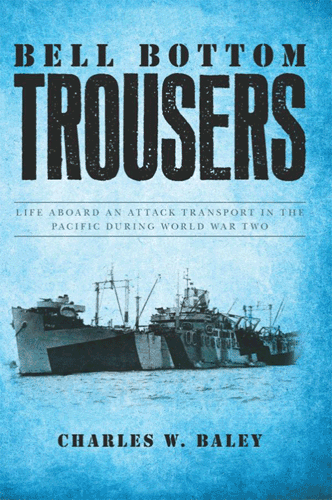
Bell Bottom Trousers: Life aboard an Attack Transport in the Pacific during World War Two
Charles W. Bailey
This story tells of the experiences of a young sailor during World War II, aboard an Attack Transport in the Pacific theater, USS President Adams (APA-19). For the first time in our history we would be fighting a two-front conflict. The war fronts were widely separated and would require different types of fighting and planning. Europe would require a large scale amphibious attack (the Normandy landings) because most of the continent was held by the enemy. But in the Pacific theater, with its many islands, both large and small, the conditions necessitated an almost continuous amphibious war, for which we were not prepared. Neither we nor our Allies possessed suitable landing craft for large-scale amphibious operations of this type. Fortunately, Andrew J. Higgins had developed a prototype landing craft that would win the war for the Allies--- the famed Higgins boats of World War II.
But as good as these landing craft might be, they could not cross oceans or other large bodies of water under their own power. These boats required mother ships (transports and cargo ships) capable of carrying troops and all their equipment and supplies and all the other things needed for a successful invasion. Just any old ship wouldn’t do; amphibious operations required a special type of ship. These transport and cargo ships needed to be able to load and unload all their troops and all the troop’s equipment using only their own boats and their own crew members as stevedores, thus giving birth to the Attack Transports (APAs) and Attack Cargo Ships (AKAs). Later, LSTs (Landing Ship Tanks) and LCIs (Landing Craft Infantry) were added to the mix. Warships could shell enemy positions and warplanes could bomb enemy positions, but in the Pacific theater it took ground troops (Army or Marines), carried there by APAs and AKAs, to finish the job. Although, such sailors never received the recognition and glory given the “Glamour Ships”, they wore their Bell Bottom Trousers with just as much pride and luster as their comrades who served on the warships.
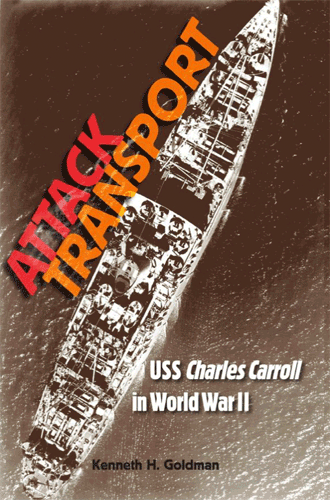
Attack Transport: USS Charles Carroll in World War II
Kenneth H. Goldman
In November 1942, the amphibious transport ship USS Charles Carroll carried troops from Norfolk to invade North Africa. In 1945 it was transferred to the Pacific for the invasion of Okinawa. In between, the "Lucky Chuck," as the ship was fondly known, participated in the invasions of Sicily, Salerno, Normandy, and southern France. Attack Transport tells the service history of USS Charles Carroll (APA-28 which earned six battle stars during WWII.
Kenneth Goldman's father, Lt. Robert W. Goldman, USNR, was aboard ship for five of her six battle operations. As a junior officer (he eventually became the ship's navigator), he held a high security clearance and saved a large portion of the documents to which he was privy. These invasion maps, photographs, ship's plans of the day, convoy position orders, enemy force assessments, and more form the backbone of Attack Transport.
Yet Goldman graciously keeps his father out of center stage in telling the "life" of a ship that participated in almost all of the major U.S. amphibious assaults in the European Theater. Using weathered diaries and letters from other crew members, along with their memories of service, he captures the humor, boredom, combat fears, and capers on liberty that give this view from the lower deck a charm that operational histories do not have.
"Offers a cascade of authentic information and 'flavor' on going to sea that I recognize as quite authentic from my own experiences and gives rare insights into wartime naval service of a ship type not usually covered in the spate of 'war as I knew it' memoir. The shipboard routine reveals itself in gritty and authentic prose." – Kenneth W. Estes, author of Marine Officer's Guide
"Fills a marked gap in our knowledge of the period; namely an up close and personal view of the brave men and gallant ships handling the various D-Days." – William O. Oldson, Director, Institute on World War II and the Human Experience, Florida State University
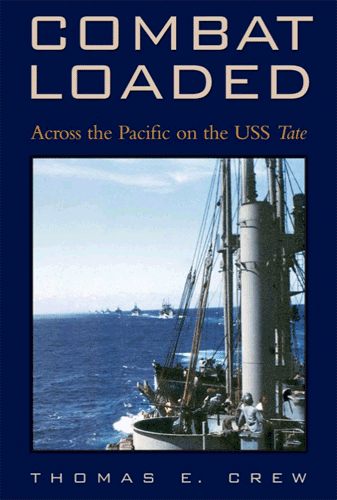
Combat Loaded: Across the Pacific on the USS Tate
Thomas E. Crew
The first authoritative history of any of the more than 350 attack transports or attack cargo ships of World War II, Combat Loaded: Across the Pacific on the USS Tate contains gripping combat narratives alongside the sometimes heartwarming, sometimes tragic details of daily life on board the ships of Transport Squadron 17 during the waning days of World War II.
Author Thomas E. Crew interviewed over fifty veterans of the attack cargo ship USS Tate (AKA-70), including all her surviving officers. Crew weaves a rich tapestry of voices, combining it with extensive analysis of the Tate’s daily action reports and ship’s logs, accented by lively letters of the period from private collections—including previously unpublished accounts of the last days of famed war correspondent Ernie Pyle.
Crew also presents a rare unit-level perspective of joint operations involving the infantry fighting ashore and the navy transports that sustained them with their vital combat cargo. The resulting richly illustrated work presents perhaps the most comprehensive account to date of the experiences and courageous contributions of those who served on amphibious transports during World War II.
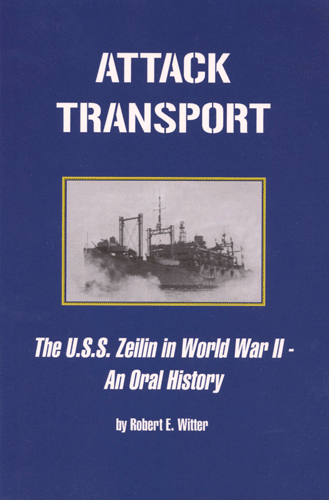
Attack Transport: The U.S.S. Zeilin in World War ll - An Oral History
Robert E. Witter
This is the story of the attack transport U.S.S. Zeilin (APA-3), as told by those who served aboard her during World War II. Within these pages a crewman tells how it felt to have a Japanese bomb drop straight toward him while stored below the sailor's feet were tons of explosives and fuel. Another relates how he helplessly watched a kamikaze bear down on his gun position while prohibited from returning fire. Most importantly, officers and crewmen recount the Zeilin's role in the invasions of Guadalcanal, the Aleutians, Tarawa, Kwajalein, Hollandia, Guam, Luzon and Iwo Jima -- and what really happened.
Boat Officer on the USS Zelin, Raymond W. Hodell said: "Before our training on the boats, we thought the Zelin was just an ordinary transport – that it took the troops back and forth… We found out how wrong we were for, right off the bat, in August, 1942, we were part of the invasion of Guadalcanal."
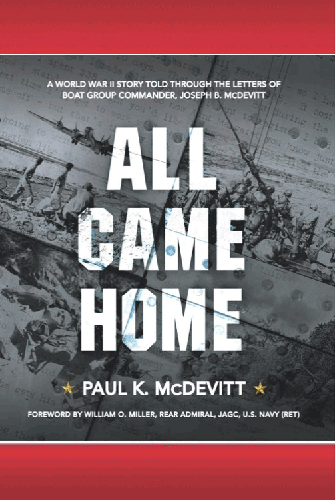
All Came Home: A World War II story told through the letters of Boat Group Commander, Joseph B. McDevitt
Paul K. McDevitt
All Came Home is a true story of junior reserve officer Joe McDevitt, as told through letters mailed home to his family. McDevitt served on the attack transport USS Leon (APA-48) in the Pacific during WWII.
This is a quintessential American story about a youngster of German and Irish ancestry striving to achieve the American dream. Then comes WWII, and Joe postpones his driving personal ambition in order to enlist in the Navy. He joins the Pacific Amphibious Forces where men wage war on the open water in small boats. Could the Navy really make a warrior out of him… someone who thinks of nothing else but the sea and the war? A romance flourishes, and, like many of his peers, Joe must choose: marry now, and leave a young war bride behind, or wait to wed his true love when, and if, he returns? At war, he endures one bloody assault after another: ground-shaking bombardments, thundering artillery and mortar barrages, and the conviction that chance alone determines who lives and who dies. One way or another, all came home…
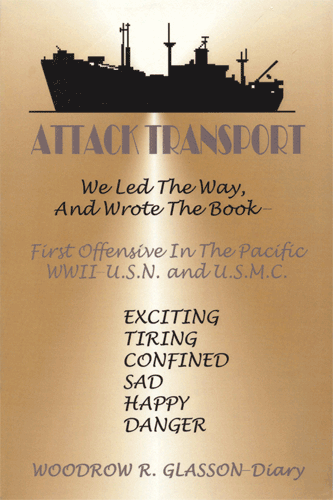
Attack Transport: We Led the Way, and Wrote the Book-First Offensive in the Pacific WWII-USN and USMC
Woodrow Glasson
Attack transports formed the backbone of the Amphibious Forces in World War Two. It was these ships that carried the bulk of the troops and equipment to the bloody assault beaches of the overseas landings. The Japanese military had swept across Pacific Ocean conquering and fortifying hundreds of small islands that the Allied forces would have to conquer one by one in order to defeat their enemy. Despite being unarmored and having little fire power, attack transports continued to make a monumental impact in the fate of the war. Not because they could defeat the Japanese on their own but because they carried in their hulls the war’s one essential combat element: the troops that fought on the ground.
Attack transport USS President Hayes (APA-20) and her sister ships President Adams and President Jackson, for a total of nineteen attack transports, along with twelve to fifteen hundred U.S. Marines aboard each ship, made the first offensive in the Pacific in WWII. President Hayes’ journey began August 7-9, 1942. Making initial landings on Guadalcanal, Talagi, Russels, Rendova and Bouganville Islands, in the Soloman Island chain in the west and southwest Pacific Ocean, the U.S. Navy was slowly developing the techniques for amphibious landings. One after the next, Japanese-occupied islands were vanquished. By recapturing these islands, the Japanese military was halted from any further advance.
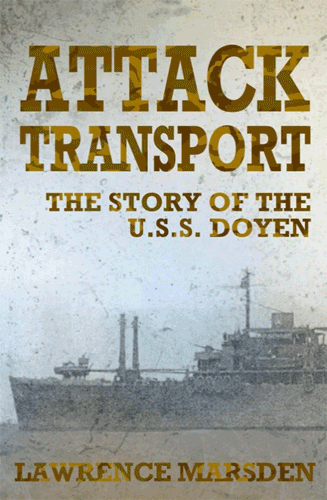
Attack Transport: The Story Of The U.S.S. Doyen
Lawrence A. Marsden
Lawrence Marsden’s fascinating book uncovers the action of the U.S.S. Doyen (APA-1) from commissioning through to her last operation in World War Two and of course exposes the lives of the men who sailed her through treacherous waters to do their duty.This book provides brilliant insight into the Pacific War as it was seen from one small unit in the fleet as they were involved in some of the most important operations of that front, including the invasions of Kiska, Tarawa, Kwajalein, Saipan, Guam, Leyte, Lingayen Gulf and Iwo Jima.
Lieutenant Commander Lawrence A. Marsden served on the U.S.S. Doyen from May 1944 through to the end of the war, and was involved in the landings at Saipan, Guam, Leyte Gulf, Luzon and Iwo Jima. After the war he resigned his commission and became a textile company executive. His book Attack Transport: The Story of The USS Doyen was first published in 1946 and he passed away in 2005. This book is perfect for readers who wish to learn more about these fascinating boats, the men who fought aboard them and the impact that they made throughout the war.
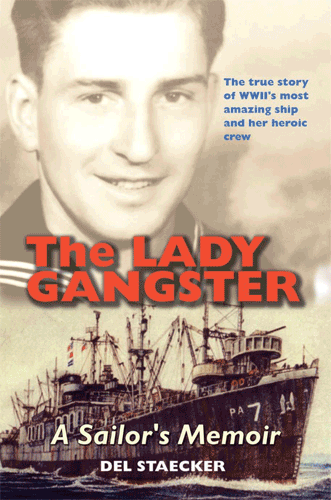
The Lady Gangster: A Sailor's Memoir
Del Staecker
This is the story of one of World War II's most amazing armed transport ship, the USS Fuller (APA-7), and her equally amazing crew, as they delivered troops and supplies to most of the toughest battles fought in the South Pacific. It is also the tale of how a simple question brought a father and son together. This remarkable story began in 1967 with a broken car radio and a father-and-son's cross-country trek. The two had been making uncomfortable small talk until the son asked, "Dad, will you tell me what you did in the war?"
The father's answer is the amazing first-hand account of the USS Fuller, 'The Lady Gangster,' an attack transport and its courageous crew of "Chicago Boys" who transformed from wide-eyed new recruits to weathered "Old Salts" braving enemy attacks while delivering troops and supplies during many of the toughest battles in the South Pacific during World War II. It is also the poignant tale of how a simple question forged a lasting bond between a father and a son.
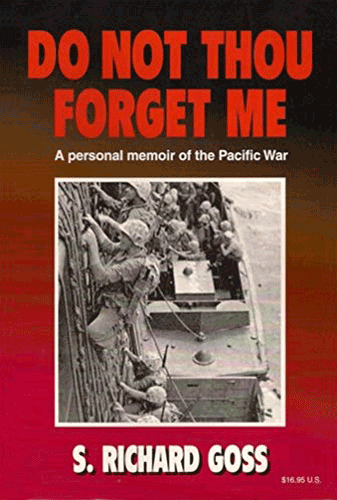
Do Not Thou Forget Me: A Personal Memoir of the Pacific War
S. Richard Goss
This is a fascinating firsthand account of the Pacific War by one who was there. As an officer aboard a Navy attack transport, USS Bladen (APA-63), Dick Goss participated in the conquest of Iowa Jima and Okinawa. His narrative documents both the massive logistical effort required for these operations and the ferocity that characterized combat in this theater. Yet his story remains a personal memoir with as much detail to officers' training and shore leave in Noumea as in resisting kamikaze attacks. From the V-12 Program at Bucknell through the atomic bomb test at Bikini, Mr. Goss epitomizes an American generation's odyssey through war to victorious peace.
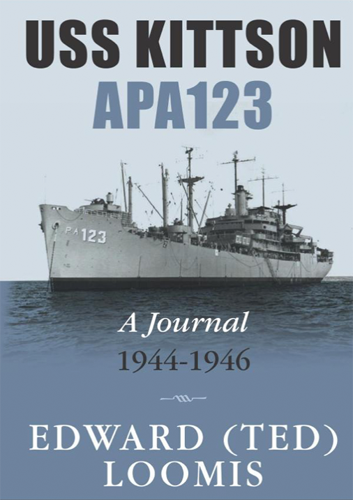
USS Kittson APA123: A Journal
Edward (Ted) Loomis
This narrative describes the course of the USS Kittson (APA-123), a Haskell-class attack transport, from island to island, including the preparations for and the invasion of Okinawa; the distribution of personnel to various islands, including the Philippines, Okinawa, Japan, and China; and the assignment of the ship to "Magic Carpet" duty before its final return to the US and decommissioning at Norfolk, Virginia.
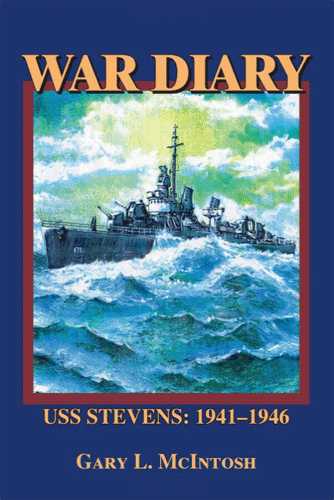
War Diary, USS Stevens: 1941–1946
Earl L. McIntosh
The destroyers of World War II were the workhorses of the fleet, but their contributions have been largely forgotten in the passage of time. Even during the war, official reports listed the names of all battleships, cruisers, and aircraft carriers participating in an operation, but the destroyers that escorted the Task Group and drew the dangerous close in fire support tasks were seldom listed by name or hull number. They were grouped in classifications such as "fourteen Destroyers" or merely, "fourteen escorts."
Drawing on official records and the memories of the men who fought in the Pacific War from its decks, Gary McIntosh has created a highly readable history of the USS Stevens (DD-479), a Fletcher-class destroyer that participated in some of the better known invasions of the war and some that have been virtually forgotten. Spanning the years from the time the ship was launched in June 1942 until it was decommissioned in September 1946, few books have ever chronicled the life of a single ship the way this one does. Tin Can Sailors and landlubbers alike will enjoy this story of life aboard a destroyer during the greatest conflict the world has ever known.
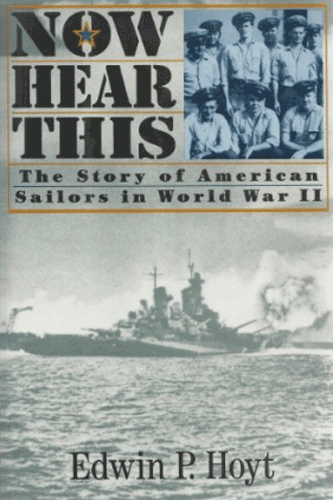
Now Hear This: Story of American Sailors in World War II
Edwin P. Hoyt
For there first time, American sailors tell the story of the U.S. Navy in World War II as they themselves fought in the Atlantic, the Pacific and the Mediterranean.
Here, in first-person accounts from interviews. letters and diaries, are the signs and sounds, the feel of the war as only those who were there could describe it: the sailors who manned the gun turrets, the engine rooms, the torpedo tubes, as well as the laundries, the libraries, and the kitchens.
For this book, historian Edward Hoyt contacted hundred of veteran sailors. From their responses, he has forged a powerful chain of individual stories, linked together by the larger drama of the war as it unfolded in different theaters. Hoyt follows raw recruits through basic and speciality training and from there into combat and exhaustion, boredom and sheer terror, losses and lucky escapes, snafus and successes. Hoyt chronicles how the U.S. Navy, with little time for training, transformed itself into the greatest force at sea. It did this by becoming the navy of the common man and Hoyt has recorded the voices of the common sailors who made it happen.

